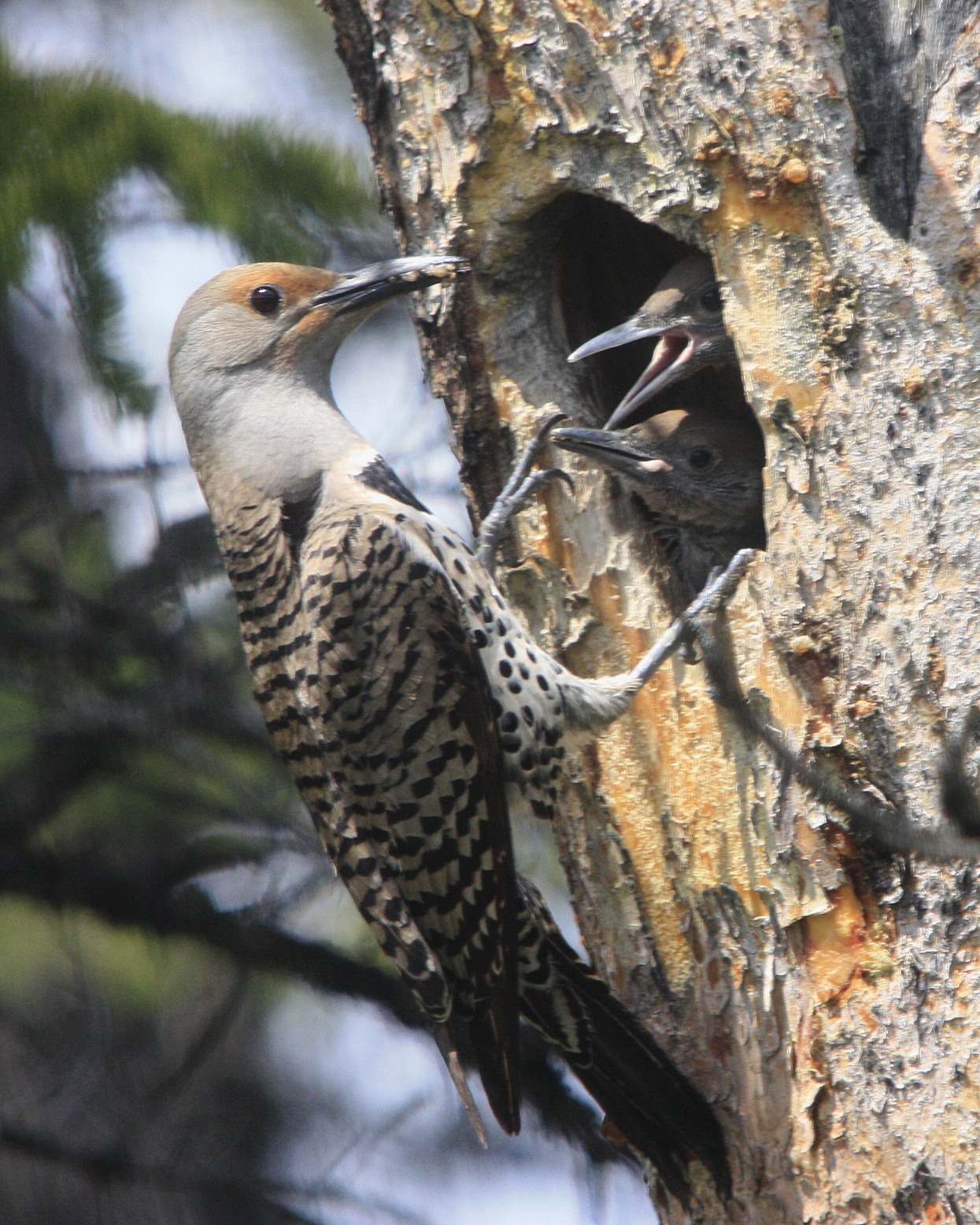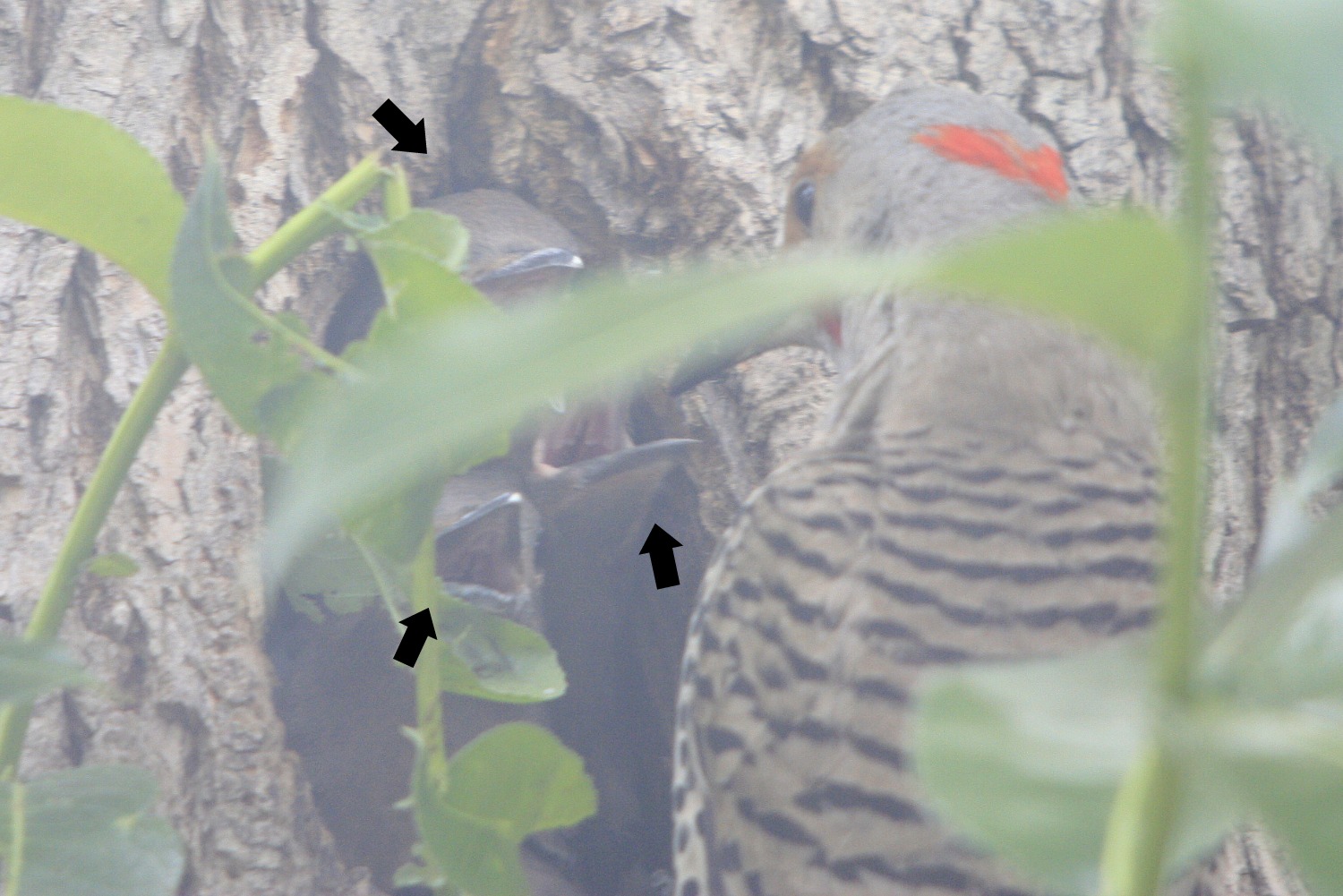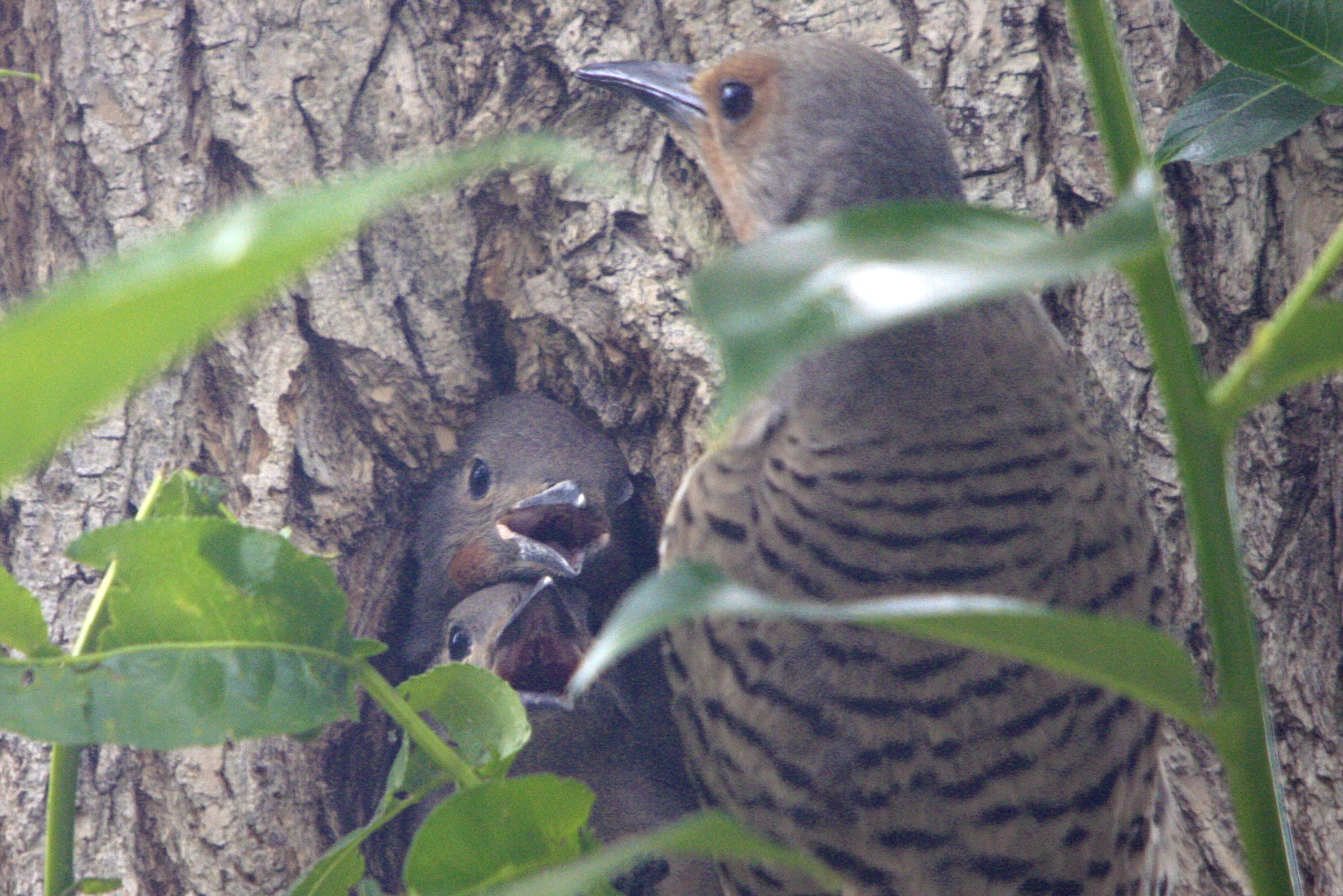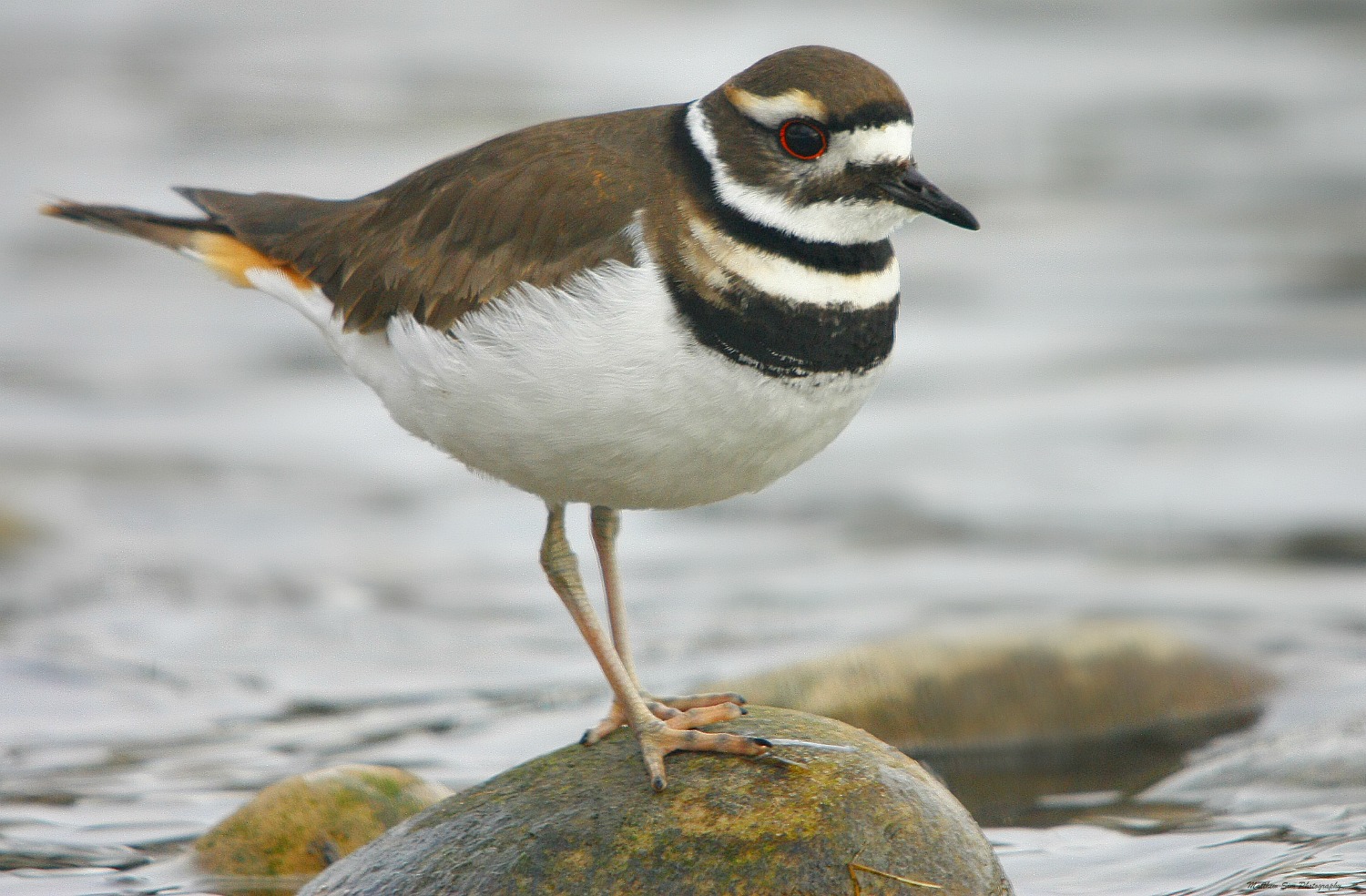Snow buntings are notoriously difficult to photograph, as they’re always in motion. Duane Starr was lucky to run into thousands & thousands of them and managed to get a series of wonderful pictures of these hyperactive little birds. He says when the flock was in the air they were everywhere and when they were on the ground they were everywhere. Click here to view his snow buntings on the fence, in the air, on the ground…
Archives
Snowy Owl Action Shots
Duane Starr has had some excellent snowy owl luck lately, and sent us a couple of links to his photo galleries.
The first set has some wonderful in-flight and action shots. Click here to view, then click on Slideshow on the right hand side.
His second set of snowy pictures shows the complete sequence of an owl coughing up a pellet, which looks like an extreme amount of hard work! View here.
Movie Time: Bohemian Waxwings
Posted by Pat Bumstead
Monitoring a Flicker nest
Posted by Matthew Sim
As spring approaches once again, I like to reminisce about the previous year and all of its most exciting moments.
For the past several years, flickers have nested in my neighbor’s tree. I had never really observed this nest closely before; however, last year, I did just that. Flickers usually excavate nest holes in dead or dying tree trunks or large branches. These nest holes are most often found at 6-15 feet off the ground and will often be reused. By late May/ early June in Calgary most flickers have laid their 5-8 white eggs. I started to notice that the flickers were more active around the nest in early June and it is my belief that on around the 3rd or 4th of June, “my” pair laid their eggs.
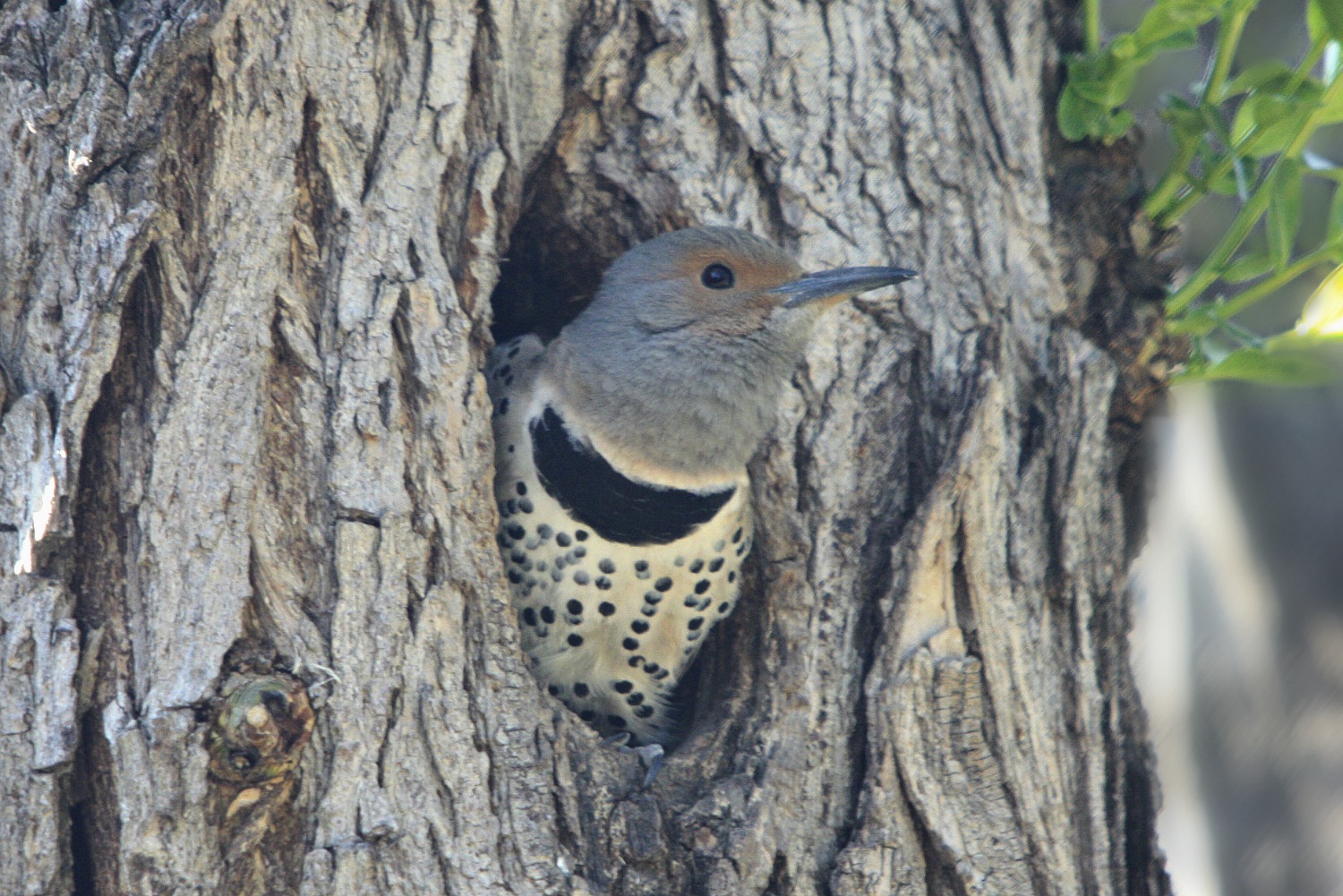
- This is the nest hole with the female looking out on June 10. The flickers had been in and out of the hole since late May
Incubation of the eggs ranges from 14-16 days and I had been closely following all the bird’s actions in attempt to discover when the eggs would hatch. On June 24, I heard the first sounds coming from the hole. The flickers had been born! I think that we can assume that there is a possibility that the young flickers were born a day or two earlier and I had not heard them until then.
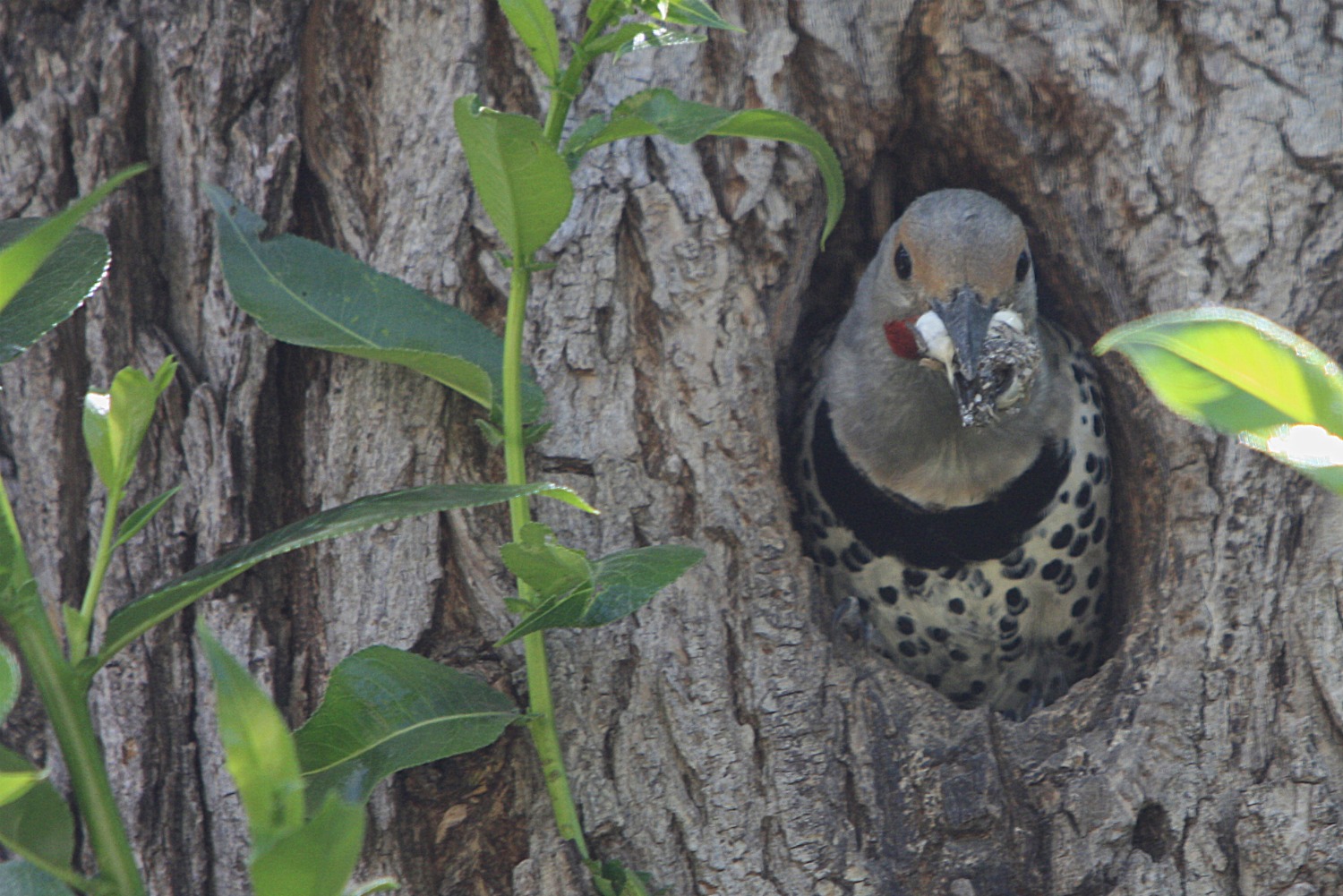
If you compare this shot with the photo above, you can see that the leaves around the hole grew a lot as the summer progessed, adding even more security and privacy to the flicker residence.
The first visible evidence of the young flickers was the clean-up crew. As all parents can attest to, there is a lot of cleaning up involved with kids. The adult flickers, both male (pictured in photo above) and female, had to work constantly to ensure that their young were well-fed, safe from predators and, perhaps most importantly, in a clean home.
July 1st came around and I had still not seen the young flickers, though I had definitely heard them. Each and every day they were getting louder and louder and soon I could hear them from across the alley, in my yard, maybe 35 feet away. The young flickers cry is often described as a hissing noise and is uttered for two weeks, day and night, growing stronger as the birds grow older. I was not worried about not having seen the flickers yet as their eyes do not open until they are ten days old, so wouldn’t be seeing them until then. July 3, I was up in Banff, where I happened upon a flicker nest with two young already poking their heads out of their hole. At that point, I couldn’t help but wonder how my flickers were doing.
July 5th, marked a special day for my monitoring project. That day, I got my first glimpse of the young flickers. I took my first photos of the young flickers on July 9th, and they were looking healthy and fit; all 3 of them!
But that’s where it went all wrong. The nest holes of flickers (and often of many other species of birds) are the scenes of very fierce battles. Three young birds with very sharp bills, duking it out for supremacy and the right to remain looking out of the nest hole, therefore receiving the most food. The stronger birds almost invariably end up on top, and maintain their authority by jabbing the others with vicious pecks of their beak. The opening is only big enough for two heads and the third one gets pushed to the bottom. There, the young flicker receives very little food and consequently, it perishes. July 9th, I took the photo above, showing 3 young flickers. By the next day, July 10th, I was only seeing 2 young flickers.
Disappointed though I was, I realized that sometimes, this is the way nature must work. I continued to watch the flickers for several days, amazed at the rate at which they grew. After about 4 weeks, the flickers would fledge and would begin to leave the nest; my flickers started appearing out of the nest around July 16th. The two young birds started hopping about and practicing flying, getting ready for the day when they would leave the nest altogether.
Than one day, I did not see the flickers. Nor did I see them the next day. Or the day after that. It would seem that the two young flickers that I had watched for a nearly a month had successfully fledged. I don’t think I ever saw these two again, though I was seeing flickers in the neighborhood, which might just have been one of the young. From time to time, I did hear the distant call of several Northern Flickers and I couldn’t help but wonder if it was the fledgelings, calling away.
Saw-whet Owl and Pellet
Posted by Bob Lefebvre
By now most birders in Calgary have heard about the Northern Saw-whet Owl that was found in Carburn Park last Thursday. Phil Smith was there when it was found, and he captured an amazing sequence of pictures that show the owl coughing up a pellet.
Owls and many other birds regularly regurgitate pellets, which consist of the indigestible parts of the food they eat. Saw-whet owls eat a lot of Deer Mice, and their pellets contain mostly bones and fur.
Although these owls are thought to produce one pellet per day, it is a rare sight to see, and even rarer to photograph. The pictures have been assembled into a short video.
.
Below is the complete sequence of photos showing the owl coughing up the pellet. (Photos by Phil Smith, used by permission.)
To see more of Phil Smith’s photos, see his Flickr Page.
Anne Elliott also captured a photo of the pellet being produced:
To see more of Anne Elliott’s photos, see her Flickr Page.
Winter Killdeer
Last weekend on the Christmas Bird Count, I came across a very photogenic Killdeer. These abundant shorebirds, usually only stay the summer in Calgary, several birds, however, also stay the winter.

Despite our frigid winters, these hardy Killdeer seem to manage all right, we see them throughout the winter which must mean that they are surviving. They are definitely finding food, as can be seen in the photo below.

This Killdeer seemed to be finding enough food
At one point, I even saw this particular bird with a small morsel of food clenched in its beak.

This Killdeer was fearless and approached me; which is quite a nice change as a photographer! It also engaged in the species peculiar method of moving; they run for a few feet, stop, look around, flick their tail up, bob their head up and down a couple times, and then repeat this cycle over again.

Just finished a short run, the Killdeer stops, looks around and...

Bobs it's head out of the photo, leaving the photographer with an unusual result; but a good story!
Each year, Killdeer are seen wintering in Calgary, somewhere on the Bow River. Though it may seem like a daft idea to many of us, this species obviously are doing just fine!
A Merry Christmas to you from all of us here at the blog!
Posted by Matthew Sim
Schoolyard Swainson’s
Last July, right before I moved to Texas, I was treated to an incredible sight: a dark-morph Swainson’s Hawk perched on a fence in a school parking lot. This hawk was incredibly close to the sidewalk and allowed for some great photos, all the while sitting calmly on its perch.
This hawk didn’t seem to be injured, it just seemed to be very tolerant of people. Supposedly, Swainson’s Hawks are accepting of human activity and tolerate even more in areas where this activity is more frequent. This species will often become accustomed to disturbance from humans, thus the higher level of tolerability. This hawk, however did still seem to be giving me the evil eye!
After a couple minutes, the impressive raptor, slowly turned away (above) and resumed its activities as if I wasn’t even there.
This is not the first time this year that a Swainson’s Hawk has allowed me to get very close to it, back in May, while we bloggers were doing the Big Sit, we observed a Swainson’s that allowed us to watch it from merely several feet away http://birdscalgary.wordpress.com/2011/05/15/swainsons-hawk/.

This was definitely one of the cooler birding parts of the summer!
Posted by Matthew Sim
Wintering blackbirds in Texas
Winter leaps upon us in a flash. One minute, it seems, it is a very distant shape looming faintly on the horizon. Suddenly, before we know it, winter has struck, leaving us wondering where the summer went. In Texas, the same seems to happen with wintering birds. One day, only the year-round residents who call Texas home can be seen. The next day, countless wintering birds of all shapes and sizes are everywhere, confusing even the most attentive eye.

Countless blackbirds flock together during the winter
On a recent trip to Brazos Bend State Park here in Texas, about an hour southwest of Houston, we observed some spectacular flocking in action. Literally thousands upon thousands of blackbirds; Red-winged Blackbirds, Brown-headed Cowbirds, Common Grackles and European Starlings congregating on some farmer’s fields. They swarmed and swirled, seemingly in perfect coordination, lifting off and landing as a unit. And yet, this is not a sight you can readily behold on these bird wintering grounds. You don’t see flocks of thousands of these species doing this in the summer, so why do they do it in the winter???

These blackbirds have quite a few reasons for doing this in the winter but these flocking habits also have numerous downsides. First of all, on the positive side, foraging is greatly improved by the large flock as opposed to a single bird or a small group. The more eyes you have working together, the easier it is to find food! More eyes can also mean more safety from would-be predators, and trust me, there are a lot of them!
This brings us to one of the downsides of wintering flocks. Predators. Lots of them. Where there is food, there are consumers, waiting to, well, consume the food. Raptors see these blackbirds as one huge buffet just waiting to be sampled. In a small farmer’s field, we counted up to 20 raptors: about 10 Caracaras, many Red-tailed Hawks, several White-tailed Hawks, a Turkey Vulture and a couple of Northern Harriers, all exploring the delightful opportunity of a full stomach all winter long. If these hawks were to stick with the group of blackbirds, they could potentially always find one or two to pick off from the pack. The more birds in a flock, the more noise and commotion they make, rendering them easily visible targets.
Large concentrations of any living thing invariably bring with them two other depreciating factors; disease and competition. Avian diseases can be spread very quickly in such large flocks and may sometimes ravage a great portion of the local species. More birds might find better food sources but if there isn’t enough to go around, there simply isn’t enough. Weaker, slower and sick birds often will be the first to go hungry as they cannot compete with the healthier individuals.
It was definitely a neat sight to behold, especially when a raptor would plunge into the center of the throng, sending up explosions of blackbirds. One of the White-tailed Hawks that we spotted, an immature, had a very full crop (a muscular pouch near the throat used to store food), showing us that it had been eating well recently.
In the end, the advantages of these congregations greatly outweigh the disadvantages and it is a bewildering sight that will continue to captivate many a fortunate observer.
Posted by Matthew Sim



